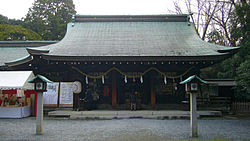- Minase Shrine
-
Minase Shrine
水無瀬神宮
Front view Information Type Imperial Shrine Dedicated to Emperor Go-Toba, Emperor Tsuchimikado and Emperor Juntoku Founded 1240 Minase Shrine (水無瀬神宮 Minase jingū) is a Shinto Shrine in Shimamoto, Osaka[1]
The Shrine is dedicated to the veneration of the kami of Emperor Go-Toba, Emperor Tsuchimikado and Emperor Juntoku.[1] In the struggle with the Kamakura shogunate, the three historical figures are united by one common factor—each was overpowered and banished from the Imperial center in Kyoto: Go-Toba was banished to Oki Island, where he died.[2] Tsuchimikado felt compelled to abandon Kyoto, traveling first to Tosa province (now known as Kōchi Prefecture); and later, he removed himself to Awa province, where he died in exile.[3] Juntoku was forced to end his days at Sado Island.[4]. In 1873, the kami of Go-Daigo and Tushimikado were enshrined in 1874; and the kami of Juntoku was enshrined in 1874.[5]
Contents
Kanpei-sha
In 1871, the Kanpei-sha (官幣社) identified the hierarchy of government-supported shrines most closely associated with the Imperial family.[6] The kampeisha were shrines venerated by the imperial family. This category encompasses those sanctuaries enshrining emperors, imperial family members, or meritorious retainers of the Imperial family.[7] Up through 1940, the mid-range of Imperial shrines or Kanpei-chūsha (官幣中社) included the shrine; and it was then known as Minase-gū[8] In 1940, Minase's status was changed Kanpei-taisha (官幣大社), which is the highest rank; and since then, it has been known as Minase jingū.[9]
See also
- List of Jingū
- Modern system of ranked Shinto Shrines
- List of National Treasures of Japan (ancient documents)
Notes
- ^ a b Ponsonby-Fane, Richard. (1959). The Imperial House of Japan, p. 126.
- ^ Brownlee, John S. (1991). Political Thought in Japanese Historical Writing: From Kojiki (712) to Tokushi Yoron (1712), p.104.
- ^ Takekoshi, Yosaburō. (2004). The Economic Aspects of the History of the Civilization of Japan, Volume 1, p. 186.
- ^ Bornoff, Nicholas. (2005). National Geographic Traveler Japan, p. 193.
- ^ Holton, Daniel Clarence. (1922). The Political Philosophy of Modern Shintō, a Study of the State Religion of Japan, p. 273.
- ^ Ponsonby-Fane, Richard. (1959). The Imperial House of Japan, p. 124.
- ^ Institute for Japanese Culture and Classics, Kokugakuin University: Glossary of Shinto Names and Terms, Kampei Taisha.
- ^ Ponsonby-Fane. Imperial, p. 125.
- ^ Ponsonby-Fane, Richard. (1963). The Vicissitudes of Shinto, p. 394.
References
- Bornoff, Niholas. (2005). National Geographic Traveler Japan. Washington, D.C.: National Geographic Society.
- Brownlee, John S. (1991). Political Thought in Japanese Historical Writing: From Kojiki (712) to Tokushi Yoron (1712). Waterloo, Ontario: Wilfrid Laurier University Press. ISBN 0-88920-997-9
- Holton, Daniel Clarence. (1922). The Political Philosophy of Modern Shintō, a Study of the State Religion of Japan. Chicago: University of Chicago Libraries. OCLC 2857479
- Ponsonby-Fane, Richard Arthur Brabazon. (1959). The Imperial House of Japan. Kyoto: Ponsonby Memorial Society. OCLC 194887
- _______________. (1962). Studies in Shinto and Shrines. Kyoto: Ponsonby Memorial Society. OCLC 399449
- _______________. (1963). The Vicissitudes of Shinto. Kyoto: Ponsonby Memorial Society. OCLC 186605327
- Takekoshi, Yosaburō. (2004). The Economic Aspects of the History of the Civilization of Japan, Volume 1. London: Taylor & Francis. 10-ISBN 0-415-32379-7/13-ISBN 978-0-415-32379-6
Coordinates: 34°53′06″N 135°40′23″E / 34.8849°N 135.673°E
Shinto shrine Shinto architecture Buildings - chōzuya or temizuya
- haiden
- heiden
- hokora
- honden / shinden / shōden
- kagura-den
- massha
- sessha
Architectonic elements Styles - hirairi-zukuri
- tsumairi-zukuri
- gongen-zukuri
- hachiman-zukuri
- hiyoshi-zukuri
- irimoya-zukuri
- ishi-no-ma-zukuri
- kasuga-zukuri
- kibitsu-zukuri
- misedana-zukuri
- nagare-zukuri
- ōtori-zukuri
- owari-zukuri
- ryōnagare-zukuri
- shinmei-zukuri
- sumiyoshi-zukuri
- taisha-zukuri
Others Implements Main kami Staff Head shrines1 - Fushimi Inari Taisha
- Usa Hachiman-gū
- Ise Grand Shrine
- Dazaifu Tenman-gū
- Munakata Taisha
- Suwa Taisha
- Hiyoshi Taisha
- Kumano Nachi Taisha
- Tsushima Shrine
- Yasaka Shrine
Miscellaneous 1 (in order of the size of the shrine network they head)
Categories:- Jingū
- Shinto shrines in Osaka Prefecture
- Shinto stubs
Wikimedia Foundation. 2010.
